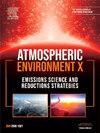Manifesting the hidden pollutants: Quantifying emissions and environmental impact of petroleum refinery on PM2.5
IF 3.4
Q2 ENVIRONMENTAL SCIENCES
引用次数: 0
Abstract
This research thoroughly examined the emissions of primary fine particle and precursors of secondary particles (VOCs, SO2 and NOx) originating from the petroleum refinery operation. The central aim was to quantify the emission factors of fine particulate matter and analyze their spatial dispersion and source contributions, in order to evaluate their environmental impacts.
The VOCs emission measurement appeared that the wastewater treatment plant unit was the most significant source of VOCs emissions, with pentane, cyclopentane, and propane being the dominant VOCs species released. The study employed the secondary organic aerosol potential (SOAP), sulfur oxidation ratio (SOR), and nitrogen oxidation ratio (NOR) methodologies to calculate the emissions of secondary PM2.5. The combustion stacks were the principal contributor to secondary PM2.5 emissions, with SO2 being the predominant secondary PM2.5 precursor species contributing to fine particulate matter, accounting for 82.5% of the total secondary PM2.5 emissions. The overall emission factor for the refinery was determined to be 0.31 g secondary PM2.5 per kg of refined crude oil. Furthermore, the analysis indicated that the combustion stacks were the primary contributors to PM2.5 concentrations at all receptor sites, accounting for 64.4%–80.8% of the total contribution, followed by the wastewater treatment unit and storage tanks. The study underscored the importance of focusing on secondary PM2.5 precursor emissions to effectively reduce emissions and environmental concentrations of PM2.5, highlighting the potential for more effective management and mitigation strategies targeting these precursors.
显现隐藏的污染物:量化石油炼制对 PM2.5 的排放和环境影响
这项研究全面考察了石油炼制过程中产生的一次细颗粒物和二次颗粒物前体物(挥发性有机化合物、二氧化硫和氮氧化物)的排放情况。VOCs 排放测量结果表明,污水处理厂装置是最主要的 VOCs 排放源,其中戊烷、环戊烷和丙烷是主要的 VOCs 排放物种。研究采用二次有机气溶胶潜能值(SOAP)、硫氧化比率(SOR)和氮氧化比率(NOR)方法来计算二次 PM2.5 的排放量。燃烧烟囱是二次 PM2.5 的主要排放源,二氧化硫是导致细颗粒物的主要二次 PM2.5 前体物种,占二次 PM2.5 排放总量的 82.5%。炼油厂的总体排放系数被确定为每公斤精炼原油 0.31 克二次 PM2.5。此外,分析表明,燃烧烟囱是所有受体点 PM2.5 浓度的主要来源,占总来源的 64.4%-80.8% ,其次是废水处理装置和储罐。这项研究强调了关注 PM2.5 的二次前体排放以有效减少 PM2.5 排放和环境浓度的重要性,突出了针对这些前体采取更有效的管理和减缓战略的潜力。
本文章由计算机程序翻译,如有差异,请以英文原文为准。
求助全文
约1分钟内获得全文
求助全文
来源期刊

Atmospheric Environment: X
Environmental Science-Environmental Science (all)
CiteScore
8.00
自引率
0.00%
发文量
47
审稿时长
12 weeks
 求助内容:
求助内容: 应助结果提醒方式:
应助结果提醒方式:


